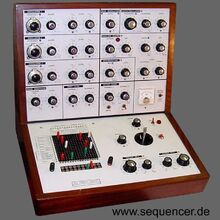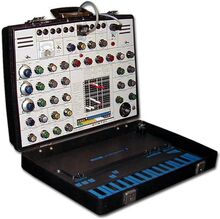
EMS VCS3, courtesy of sequencer.de
A monophonic, semi-modular analog synthesizer manufactured by EMS beginning in 1970. The acronym stands for "Voltage Controlled Synthesizer"; the '3' represents the three VCOs (one of which can be switched to low range to act as an LFO). The circuitry also includes one VCA, one low pass VCF, a ring modulator, several mixer circuits, and an analog voltmeter. The basic unit also included a two-axis joystick as its only performance control; the keyboard was an optional extra.
The VCS3 was noted for its clean and very useable panel layout. The three VCOs had multi-turn knobs for precise control of frequency. The most notable feature was the pin matrix provided for signal routing as an alternative to patch cords; all inputs and outputs were routed through the matrix, and the user created a routing by inserting pins into holes in the matrix. Color-coded pins with various values of resistance were provided for different types of routing as needed.
EMS introduced the VCS3 in 1970. It reached public prominence when Pink Floyd used one extensively on its groundbreaking Dark Side of the Moon album in 1972. Because the keyboard was extra, and the VCOs were not very stable, the VCS3 was often regarded more as a noisemaker rather than a melodic synth. Brian Eno, in his early days with Roxy Music, used a VCS3 primiarily to process signals from other band members' instruments. Pink Floyd did in fact use their VCS3 to produce many textures on DSoTM, but they also showed it could be a melodic instrument with Rick Wright's inspired solo on "Any Colour You Like", the doubling of the guitar lines on "Breathe", and elsewhere.

EMS Synthi-AKS, from Wikimedia Commons
EMS also introduced several variants of the VCS3. The Synthi-A, introduced in 1971, was a portable VCS3, with the works crammed into a briefcase-sized case, and a tighter panel with the controls closer together. The Synthi-AKS, introduced the following year, added a capacitive touch-sense keyboard in the case lid, along with one of the first digital sequencers with 256-note memory (but, unfortunately, no way to store the data). The Synthi-E was a stripped-down, low-cost model for educational use, which omitted the patch pin matrix in favor of conventional patch cords, and had only one VCO plus a dedicated LFO. Finally, the massive Synthi-100 used improved VCS3 technology in a 12-VCO monstrosity with two 64x64 patch pin matrices, a multi-channel digital seqeuncer, and a dedicated mixer, all built into a desk-sized console. Only about 20 of these were sold.
The original EMS company collapsed in 1979. After that, the rights to the designs went through various hands. A few new VCS3s, Synthi-As, and Synthi-AKSes were produced from 1980-1984. Rebuilds and reconditioning of existing units continued after that; Robin Wood (who now owns the rights) claims to be still open to orders, but there are no reliable reports of anyone taking delivery of a new unit since the mid-1980s. EMS was not good at keeping production records, so the number of units produced is in considerable doubt. Estimates for the VCS3 are in the 500-1000 range. The VCS3 and the related synths are all now highly desirable on the collector market.